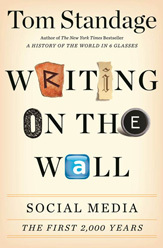 The main point made in Writing on the Wall (Amazon), the latest book by Economist journalist Tom Standage, is that social media isn’t a new phenomenon. In fact, Standage argues, media have always been social, with the exception of a relatively brief interlude starting in the early nineteenth century and now coming to an end less than two hundred years later.
The main point made in Writing on the Wall (Amazon), the latest book by Economist journalist Tom Standage, is that social media isn’t a new phenomenon. In fact, Standage argues, media have always been social, with the exception of a relatively brief interlude starting in the early nineteenth century and now coming to an end less than two hundred years later.
That period was the exception: the steam-powered printing press and later the telegraph, the radio and the television meant that media were controlled by a relatively small group of people; hence the term ‘broadcast’. Standage points to a surprising many similarities between the way news spread during most of the Common Era and the way it does now, on Facebook, Twitter and blogs.
Sure, looking for analogies between wall-graffiti found among the ruins of Pompei and today’s Facebook walls might be taking things a little too far. But it is one of the few cases where I think the analogy doesn’t really work.
The protestant reformation in Germany did get a kick-start because people spread (or retweeted) Luther’s theses. Coffeehouses were the forums of the seventeenth century – and they were frowned on for distracting their visitors from their work. The ‘blogosphere’ of late eighteenth century France did help create the atmosphere in which the French Revolution could take place, like a contemporary equivalent of Facebook had done to the American Revolution a decade earlier.
It is tempting to see social media as an entirely new phenomenon. And while some aspects of it are indeed new, social media is really an old and more natural way for news to spread. We should embrace its return.
Tom Standage is also the author of The Victorian Internet (Amazon), a book on the history of the electric telegraph that draws parallels between the early decades of the telegraph and the early years of the Internet. It combines two interests of mine that tend to be mutually exclusive: the Internet and nineteenth century history. I was thus pleased to learn that the book, which was long sold out, is back in print again.